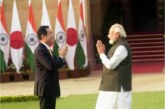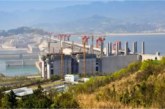China’s recent policy initiatives vis-à-vis Central Asia bespeak both the increased importance of this region to China in terms of energy and the probable impact developments obtaining in this area could cast upon Xinjiang and China’s overall state structure. These initiatives are also dictated by the fact of increasing rivalry with the United States in Russia. Beijing’s bid to float counter-coalitions against what it perceives to be U.S. ‘encirclement and potential threats’ at its doorstep is also a step in that direction. These policies are, viewed in a broad perspective, warranted by the strategic importance of energy access to China. It is a critical issue for the long-term and which already is and will be a major determinant of future policies.
The increasing militarization and strategic polarization of the Central Asian region is occurring at a faster pace. Rival security blocs are emerging to fill up post-Soviet ‘vacuum’ culminating in the gradual emanation of ‘exclusive military interests’ that are beginning to make their presence felt in the region. The Shanghai Cooperative Organization (SCO), China’s first formal show of willingness to project power beyond its borders, is but one manifestation of this trend as are its 2003-2005 exercises and growing military links among all of its members.1
Andijon massacre and ‘Tulip Revolution’ in Kyrgyzstan have further heightened China’s longstanding desire to suppress any possible external support for insurgents in its Xinjiang region. The resultant impact of these events is becoming discernible in China’s newest moves in Central Asia that reflect not just Beijing’s rising capability, but long-held great power ambitions and rising appetite for energy as well.
In the wake of this emerging scenario, China seems to have cast aside its earlier taciturnity about former Russian Prime Minister Evgeny Primakov’s strategic triangle with Russia and India and agreed to a meeting of Foreign Ministers of the three countries in Vladivostok on June 2, 2005. At this meeting the war on terror, access to Central Asian energy (including Iran), and the issue of uprisings in Central Asia were reportedly discussed among the participants. China’s growing ties with Iran, particularly after both countries signed a $70 billion energy deal in October 2004, is seen as a tacit move in that direction.
Growing Sino-Kazhak Relations
China seems to strike at the opportune moment to consolidate its foothold in Central Asia, taking advantage of the chaotic and uncertain situation after the series of anti-government upheavals in Uzbekistan and Kyrgyzstan.2 The apprehensions of a ‘rose revolution’ entail the possibility of pushing Kazakhstan into the arms of the Chinese juggernaut. The internal turmoil and its adverse impact on the present regimes in Central Asian republics have brought most of them closer to China on one pretext or the other.
The Sino-Kazhak relationship has entered the ‘strategic partnership’ phase as a sequel to the recent four-day visit of the Chinese President Hu Jintao to Kazakhstan in the first week of July 2005. The Chinese leader placed oil and gas on the top of his agenda in his talks with his Kazhak counterpart Nursultan Nazarbayev. Undoubtedly about 70 joint enterprises operate in Kazakhstan, but what really evokes China’s interest is the energy resources, uranium mines and mineral deposits of Kazhakstan. Energy cooperation is termed as the cornerstone of the Sino-Kazakh partnership. Both countries have reaffirmed to complete the construction of the Atasu-Alashankou oil pipeline from Western Kazakhstan to China by December 2005. The Russian emphasis on Siberian oil and gas reserves propels Kazakhstan’s prospects to play a dominant role in the Caspian. Eight agreements, including cooperation in areas of transport communication, trade, scientific and humanitarian partnership, and information exchange on cross-border rivers were signed during Hu Jinato’s visit to Kazakhstan. Both sides also stressed the need to increase bilateral trade that had reached $4,489 million in 2004 to $5 billion.3
On August 22, 2005, China National Petroleum Corp. (CNPC) announced its acquisition of PetroKazakhstan, the Canadian-owned Kazakhstan’s major oil company, for $4.2 billion. It seems to be one step towards securing similar concessions with major oil suppliers with friendly ties with Beijing in the region because China is in need of multiple long-term suppliers to meet its large and fast-growing fuel requirements. Undoubtedly, China’s acquisition of PetroKazakhstan is symbolic of its growing economic presence in Central Asia, at the same time it sounds an alarm to the rest of the world, and especially the United States, that China is not only seeking to meet its long-term fuel needs, but it has both options and means to achieve that objective.
The migration process in border areas of Xingjian-Uighur Autonomous Region is an alarming development. While the Russian population in the northern regions has decreased by 1.2 per cent as of January 1, 2005, the number of Uighurs in the densely populated south has risen by 1.6 per cent. This number is likely to grow in view of China’s discriminatory policy towards ethnic Uighurs. China reportedly exerted diplomatic pressure on Kazakhstan to reduce the threat from Uighur separatists in Xinjiang. Nazarbayev, on his previous visits to China, called on the 1.3 million ethnic Kazakhs in China to contribute to stability and peace.
China’s growing presence in Central Asia’s energy sector will eventually augment Beijing’s political clout and expand its political and security engagement there. Analogously, China’s dependence on Central Asia for its energy needs will make it more concerned about that region’s peace, security and stability. It is going to entail Beijing’s more active political and security involvement. Concurrently, China’s enhanced economic presence and its corresponding political influence can be a welcome move for some in Central Asia as a counterweight to increasing Russian influence and apprehensions about American dominance in the region. China is reportedly engaged in a qualitative improvement of its regional and local military capabilities. It is evincing interests in a base in Kyrgyzstan, possibly as an SCO base rather than a purely Chinese one.
Sino-Russian ‘Strategic Partnership
China is also engaged in intensifying its relations with Moscow, not just on the basis of the triangle or the SCO but in the bilateral Sino-Russian relationship and in bilateral military cooperation. Beijing and Moscow share not just common strategic goals, but more significantly, shared ideological-political aspirations to freeze the status quo in Central Asia. The agreement signed between Russia’s major Rosneft oil company and China National Petroleum Company on July 1, 2005 indicates some common ground in Russian-Chinese oil cooperation.
The present Chinese leadership seems to be relying heavily on Russia for political support as well as military hardware to repel the ‘anti-China containment policy’ which is regarded as a major foreign policy objective of the second Bush administration. The joint statement issued after a summit between Chinese President Hu Jinato and his Russian counterpart Vladimir Putin on July 1, 2005 laid stress on the opposition of the two ‘strategic partners’ to efforts by any country to ‘monopolize and dominate international affairs.’ The Chinese leader added in a press conference that both countries agreed to “further strengthen strategic cooperation, expand military exchanges and cooperation, and enthusiastically do well in the first China-Russian joint military exercise ”4 that were held in early October this year.
China is eager to acquire more sophisticated, updated versions of the fighter jets, submarines and other hardware that it has been buying from Russia in the past. Up until now, Moscow has refused to provide the latest, state-of-the-art models to China. However, Beijing’s bottom line is that Moscow must make available to China at least the same models that the latter has been supplying to India. In the aftermath of meeting of the foreign ministers of China, Russia and India at Vladivostok in early June 2005 to establish a so-called ‘strategic triangular relationship’ among the three powers of the Asia-Pacific Region, the leadership in Beijing is sanguine about Russia acceding to its request. In the wake of growing strategic partnership between Beijing and Moscow, some observers point to the probability that should China and the U.S. go to war over Taiwan, Moscow would help to pin down some American forces in other parts of the region.5 However, it seems to be far-fetched assumption.
China and Shanghai Cooperative Organization (SCO)
In recent months, China has taken steps designed to energize the Shanghai Cooperative Organization (SCO) to harness it for both bilateral and multilateral action to quell popular unrest in Central Asia and to prop it up as a palisade against Western as well as American ideas and policies about democratization. As part of this programme China has supported the SCO decision to make India, Pakistan, and Iran observers of the SCO. Both these decisions reveal Beijing’s efforts to ward off possible rivalry with India in Central Asia and to tamp down both its earlier tensions with India there and in South Asia.
It is also very possible that a series of understandings with India about energy access from Central Asia, Russia, and Iran are in the offing so that any potential rivalry with India here that could spill over into Central Asia will also be averted. By effecting these understandings with New Delhi, China hopes to reduce the possibility that India might lean to the American agenda here and be a stalking horse for Washington or even an independent rival of China’s in this increasingly sensitive, even vital sphere of its interests.
China’s active role in the SCO is perhaps designed to demonstrate to the Americans that Beijing has ways and means to not only maintain its foothold in Central Asia but also promote Central Asia’s link with South Asia. The induction of Pakistan and India as observers at the SCO may be helpful for the latter to expand its functions and geopolitical clout beyond being just a small club. There is no exaggeration in the fact that the SCO, with the addition of Iran, Pakistan and India, is likely to emerge as the biggest and most populous security and trade-oriented organization in the Euro-Asian landmass.6
Conclusion
China is gradually expanding its economic and political base in Central Asia. Beijing’s energy deals with some of the Central Asian republics as well as Iran is part of its long-term strategy to not only secure its energy and economic interests in the region but also to stem the tide of American influence there. Russia’s expanding ties with China for economic and military/security considerations are in the short term likely to eliminate its opposition to, and conflict of interests with, China. The inevitable corresponding political influence for China suits the Central Asians seeking the involvement of a growing power in their region to balance the influence of Russia and the United States.
The emerging ‘strategic bipolarity’ between the United States on the one hand and Russia, China, and Iran on the other is now being reinforced by ideological-political cleavages over democratization and human rights in both Central Asia and countries like China, Iran, and Russia. This ideological dimension can only reinforce and strengthen the already existing tensions with regard to rival strategic ambitions in and for the Caucasus and Central Asia. Under these circumstances, the possibility of making great power cooperation much harder to achieve and probable strengthening of internal and inter-state cleavages in Central Asia as domestic players can not be ruled out.
Notes
- Stephen Blank, “New Turns in Chinese Policy Towards Central Asia”, Central Asia-Caucasus Analyst, 15 June 20053.
- Marat Yermukanov, “Chinese Conundrum of Kazakhstan’s Multi-vector Policy”, Central Asia-Caucasus Analyst, 13 July 2005, p.14.
- Hooman Peimani, “China’s Acquisition of PetroKazakhstan: A Blessing or A Curse?”, Central Asia-Caucasus Analyst, 7 September 2005, p. 8.
- “China and Russian leaders agree on deepening cooperation,” China News Service, July 1, 2005; Also see, “Hu, Putin map world order,” New China News Agency, July 2, 2005.
- Zhou Liang, “Deep-seated strategic considerations behind the China-Russia joint exercises,” New Beijing Post (Beijing), June 26, 2005.
- Willy Lam, “Hu’s Central Asian Gamble to Counter the S. ‘Containment Strategy'”, China Brief, Vol. 5, Issue 15, 5 July, 2005.
Dr. Arvind Kumar : Article published in Third Concept/November 2005/Vol.19/No.225/P.No.7/


